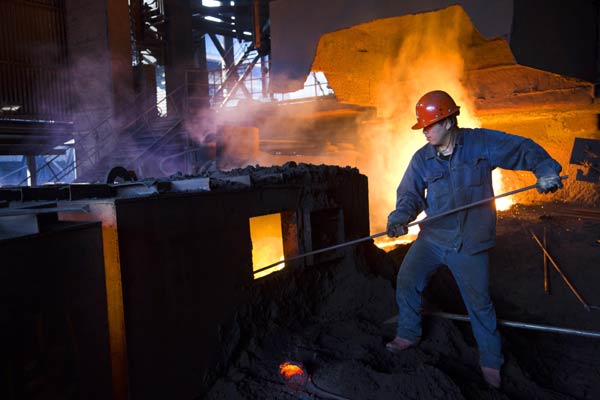 |
|
A worker stokes the furnace at a Sanming Steel (Group) Co Ltd factory in Sanming, East China's Fujian province. [YANG ENUO/FOR CHINA DAILY] |
A gauge of manufacturing activity recovered lost ground in January, suggesting stimulus measures have helped stabilize the world's second-largest economy.
The preliminary Purchasing Managers' Index from HSBC Holdings Plc and Markit Economics was 49.8, exceeding the median estimate of 49.5 in a Bloomberg survey and up from December's 49.6.
Numbers below 50 indicate contraction.
Gross domestic product expanded 7.4 percent in 2014, the slowest full-year pace in 24 years, and provinces are lowering targets for this year's expansion. Along with data this week showing industrial output and retail sales improved in December, the first reading of the economy's momentum in January may alleviate concerns of a deeper downturn.
"The gain likely reflects a positive impact from monetary easing," said Dariusz Kowalczyk, an economist at Credit Agricole CIB in Hong Kong. "The manufacturing PMI reading suggests that industrial output will continue to expand at a solid pace in coming months."
Readings on output and new orders improved in January. The report released on Friday was based on 85 percent to 90 percent of responses to surveys sent to more than 420 manufacturers.
"The economy still faces headwinds, particularly from the property sector," Julian Evans-Pritchard, China economist at Capital Economics Ltd, wrote in a note. The central bank is likely to wait for the stock market to cool before taking "more meaningful" measures such as cutting banks' required reserve ratios or lowering benchmark interest rates, he wrote.
Reiterating recent comments on its stance, the central bank will promote financial reform while carrying out pre-emptive adjustments and fine-tuning when necessary, the People's Bank of China said on Friday.
"Do not hold your breath" awaiting major monetary easing, said Liu Li-Gang, head of greater China economics at Australia & New Zealand Banking Group Ltd in Hong Kong. "The PBOC will continue to use the 2014 monetary operation model for a while.
"A RRR cut will have to wait until a below-7 percent first-quarter growth rate looks likely and the risk of deflation becomes real."
China will avoid a hard landing and is focused on ensuring long-term medium-to-fast growth, Premier Li Keqiang told global leaders in Davos, Switzerland this week. In a panel discussion at the event, PBOC Governor Zhou Xiaochuan said a moderation in growth is "good news" if it results in a more sustainable expansion.
Provinces are setting lower economic growth targets as they adjust to the "new normal" of a slower expansion pace for the world's second-largest economy.
Of seven provinces, municipalities and regions that have so far published 2015 growth targets, six have cut the rates. Economists expect the central government will lower its national target to about 7 percent from last year's 7.5 percent at the National People's Congress in March.
